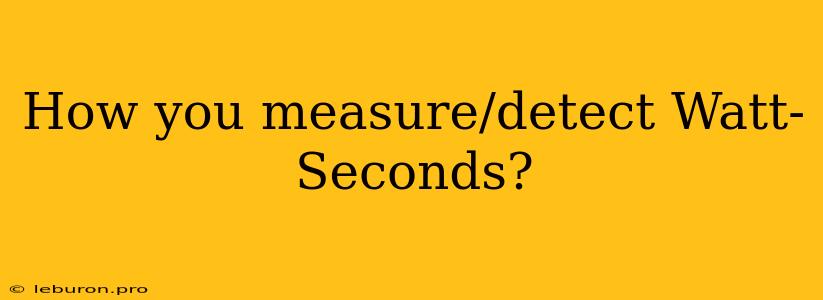Understanding the concept of Watt-seconds, also known as Joules, is crucial in various scientific and engineering fields. It represents the amount of energy transferred or consumed over a specific period. While the term "Watt-seconds" might sound straightforward, accurately measuring or detecting it involves considering different approaches and units. This article will explore the various methods and instruments used to quantify Watt-seconds, delving into their applications and limitations.
Measuring Watt-Seconds: A Comprehensive Guide
Watt-seconds, a unit of energy, measures the power consumed or delivered over a specific time. To measure Watt-seconds, we essentially need to measure both power and time. Here's a breakdown of the common methods:
Direct Measurement: Using a Wattmeter and Timer
The most straightforward method involves using a Wattmeter and a Timer.
- Wattmeter: This device directly measures the instantaneous power consumed or delivered in Watts.
- Timer: Measures the duration of the power consumption or delivery in seconds.
By multiplying the reading on the Wattmeter with the reading on the Timer, we obtain the total energy consumed in Watt-seconds.
Example: If a device consumes 100 Watts of power for 5 seconds, the total energy consumed is 100 Watts * 5 seconds = 500 Watt-seconds or 500 Joules.
Indirect Measurement: Using Energy Meters
Energy meters are specialized devices designed to directly measure the total energy consumed, often expressed in kilowatt-hours (kWh).
- kWh: A unit of energy equal to 3,600,000 Watt-seconds or 3,600,000 Joules.
Energy meters typically employ various techniques, including:
- Induction Meters: These meters utilize the interaction of magnetic fields generated by current and voltage coils to measure energy consumption.
- Electronic Meters: These meters utilize electronic circuits to measure current and voltage, converting them into energy readings.
To convert the reading from an energy meter in kWh to Watt-seconds, simply multiply the kWh reading by 3,600,000.
Detecting Watt-Seconds through Heat Measurement
For certain scenarios, particularly in applications like heating or combustion, heat measurement can be used to indirectly determine Watt-seconds.
- Calorimetry: Involves measuring the heat absorbed or released by a substance. The heat energy change can be directly related to the energy transferred in Watt-seconds.
- Temperature Sensors: Used to measure temperature changes in a system, providing data that can be correlated to the energy transferred.
Applications of Watt-Second Measurement
The measurement of Watt-seconds finds diverse applications across various disciplines:
- Electrical Engineering: Evaluating energy consumption in electrical systems, designing energy-efficient circuits, and optimizing power usage.
- Physics: Studying energy transformations in mechanical, thermal, and electrical processes.
- Environmental Science: Assessing energy consumption and efficiency in various industries and technologies.
- Renewable Energy: Optimizing the performance of solar panels, wind turbines, and other renewable energy sources.
- Healthcare: Quantifying the energy expended during physical therapy and rehabilitation activities.
Challenges and Considerations
While measuring Watt-seconds appears simple, several factors can influence the accuracy and precision of measurements:
- Power Fluctuations: Fluctuations in power consumption over time can affect the accuracy of the calculated Watt-seconds.
- Measurement Errors: Instruments used for measurement can introduce inherent errors.
- Calibration: Regular calibration of Wattmeters and energy meters is essential to maintain accuracy.
- Energy Conversion: When converting between different units, ensuring accurate conversion factors is critical.
Conclusion
Measuring or detecting Watt-seconds is crucial for understanding and managing energy consumption in various applications. Whether through direct measurement with Wattmeters and timers, indirect measurement with energy meters, or heat measurement techniques, accurate and reliable data is essential for optimizing energy efficiency, promoting sustainability, and advancing scientific understanding. By addressing the potential challenges and ensuring proper calibration, Watt-seconds can be effectively measured and leveraged to optimize various processes and systems.
